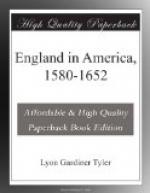While loyal to the king, the people of Virginia had never been wedded to the views of the high-church party in England. Among the ministers the surplice was not usual, and there was a Puritan severity about the laws in regard to the Sabbath and attendance at church. As the strife in England became more pronounced, the people in Nansemond and lower Norfolk counties, on the south of the James, showed decided leanings towards Parliament and to the congregational form of worship.
Soon they began to think of separating from the church of England altogether, and they sent for ministers to New England in 1642. In response, the elders there despatched three of their number, who, arriving in Virginia, set zealously to work to organize the congregations on the Nansemond and Elizabeth rivers. According to their own account, these ministers met with much success till they were suddenly stopped in the work by Berkeley, who persuaded the assembly, in March, 1643, to pass severe laws against Nonconformists; and under this authority drove them out of the land in 1644.[22]
In the same year occurred an Indian attack which these preachers and John Winthrop, the governor of Massachusetts, thought to be a special visitation of Providence. After the massacre in 1622 the war with the Indians had continued in a desultory way for over twelve years. Year after year squads of soldiers were sent in various directions against the different tribes, and by 1634 the Indians were so punished that the whites thought it safe to make peace. Now, after a repose of ten years, the fierce instincts of the savages for blood were once more excited.
April 18, 1644, was Good Friday, and Governor Berkeley ordered it to be kept as a special fast day to pray for King Charles; instead, it became a day of bloodshed and mourning.[23] The chief instigator of the massacre of 1622 was still alive, old Opechancanough, who, by the death of his brother Opitchapam, was now head chief of the Powhatan Confederacy. Thinking the civil war in England a favorable occasion to repeat the bloody deeds of twenty-two years before, on the day before Good Friday he attacked the settlers, and continued the assault for two days, killing over three hundred whites. The onslaught fell severest on the south side of James River and on the heads of the other rivers, but chiefly on the York River, where Opechancanough had his residence.[24]
The massacre of 1622 shook the colony to its foundation, and it is surprising to see how little that of 1644 affected the current of life in Virginia. Berkeley seemed to think so little of the attack that after making William Claiborne general of an expedition against the Pamunkey tribe he left the colony in June, 1645.[25] He was gone a whole year, and on his return found that Claiborne had driven the Indians far away from the settlements. In 1646 he received information which enabled him to close the war with dramatic effect. At the head of a body of cavalry he surprised old Opechancanough in an encampment between the falls of the Appomattox and the James, and brought him, aged and blind, to Jamestown, where, about three weeks later, one of his guards shot him to death.[26] A peace was made not long after with Necotowance, his successor, by which the Indians agreed to retire entirely from the peninsula between the York and James rivers.[27]




